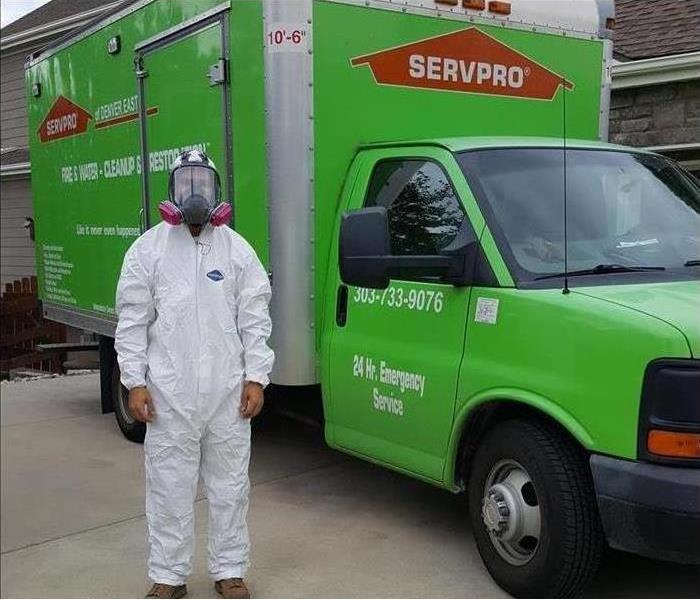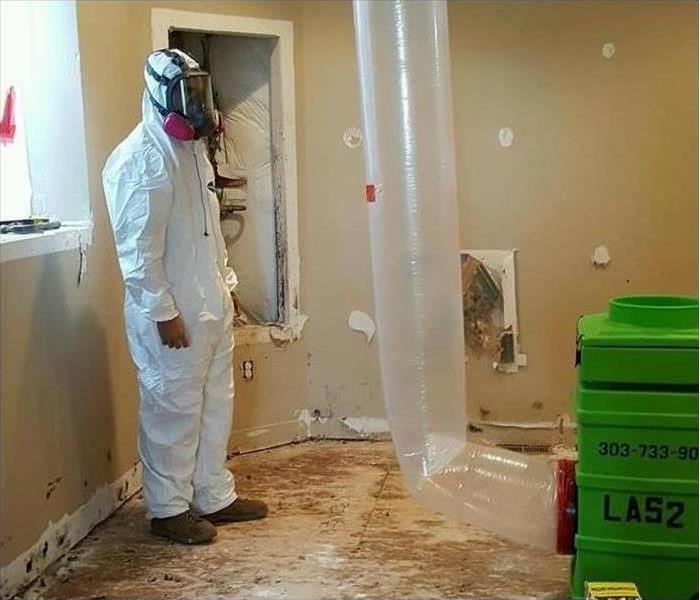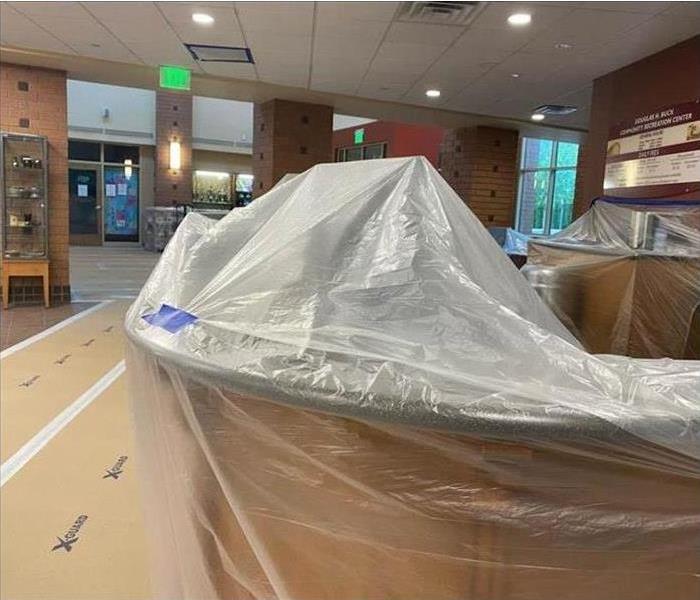Recent Commercial Posts
How to Use a Fire Extinguisher
10/7/2022 (Permalink)
A Guide to Fire Extinguisher Use
A fire extinguisher is a great tool to have around the house. It can save you from a lot of trouble, but what happens when one has to be used? This is not as easy as it may look on television! Here are some tips on how to use a fire extinguisher.
Pull the pin out.
The first thing to do is pull the pin out of your fire extinguisher. To do this, you want to make sure that it's in the correct position and that it's pointing upwards. To ensure this, turn your head so that you can see what direction your fire extinguisher is facing. Then make sure the pin is facing up before pulling it out with your right hand.
Aim at the base of the fire.
Aim the fire extinguisher low towards the base of the fire.
Squeeze the lever slowly and evenly.
You may be tempted to squeeze the lever as hard as possible or to do it as fast as you can. But neither of these methods will produce effective results. The lever should be squeezed evenly, and not too slowly or quickly. The correct way to use a fire extinguisher is by squeezing the lever until the entire extinguishing agent is discharged from the nozzle (this may take multiple squeezes, depending on how much pressure was put into each squeeze).
Sweep from side to side.
The most common mistake made using a fire extinguisher is aiming at the base of the fire and in one spot. Sweep from side to side, aiming low—not directly into the middle.
- Do not use it on grease fires.
- Do not use it on electrical fires.
- Do not use it on chemical fires or gas fires (unless specifically labeled).
This is not as easy as it may look on TV!
There are a few things you need to know before attempting to use a fire extinguisher. First, you must be able to read the instructions on the fire extinguisher label. Second, practice using it in case of an emergency.
In order for these steps to work properly, they must be followed closely by all individuals who wish to ensure the safety of themselves and others around them during dangerous situations involving flames. If you don't follow them closely then it can cause problems such as injuries while trying out different parts of your home
A fire extinguisher can be used to smother an open flame, but it is not a good idea to use one on large blazes. Instead, call the fire department if you have time and are not in danger of being injured by the blaze. A fire extinguisher should be used only for small fires that are contained or can be easily contained by a few people. If someone is burning their dinner or has lit something on fire in their home, using an extinguisher can immediately cool down the flames enough so they do not spread throughout your house or apartment building.
If your Denver home or business catches on fire, give SERPVRO of Highlands Ranch a call for fire and water damage restoration.
Mold Removal Safety Measures
5/21/2022 (Permalink)
 Our technicians wear protective gear when performing a mold job.
Our technicians wear protective gear when performing a mold job.
What Safety Measures Are Needed During Mold Removal?
When a qualified restoration company is dealing with mold growth, it will take several safety measures to reduce the spread of spores. In general, the size of the contaminated area will determine exactly what safety measures are needed. However, some mold remediation professionals decide more or fewer precautions are necessary depending on other factors. For instance, heavy growth in a small area may warrant more methods to reduce spreading spores. The major safety measures include Personal Protective Equipment (PPE) and containment.
Personal Protective Equipment
Employees wear PPE to protect themselves from exposure to spores. This is because the restoration process will cause spores and other debris to become airborne, making them easier to inhale. Some actions that high levels of PPE include:
- Breaking contaminated drywall
- Using invasive techniques in walls
- Removing wallpaper
- Running fans
Limited Containment
Limited containment is when one sheet of polyethylene is used to block off a contaminated area. The plastic sheets are secured to the floor and ceiling with duct tape. Workers will leave a slit in the plastic so they can enter and exit the site. This is typically used for workspaces that are less than 100 square feet.
Full Containment
Full containment involves placing double layers of polyethylene sheets between the moldy and uncontaminated areas. This also involves creating a decontamination chamber where employees suit up and remove moldy PPE. This room must be big enough to hold all of the employees' PPE from their respirators to Tyvek suits. It must also contain a hamper where dirty PPE can be placed. The doors to this entryway are thick flaps designed to protect people working in areas without mold.
This practice is used when more than 100 square feet of your building in Highland Ranch, CO, is contaminated. It may also be implemented if there is a higher risk that the spores could spread to other building areas.
When performing mold removal, there are several measures that professionals will take to protect themselves and the rest of the building. The most common methods include wearing PPE and containment.
4 Ways to Prevent Mold Growth in Humid Conditions
4/11/2022 (Permalink)
Prevent Mold Growth in Humid Conditions
Property owners in Carriage Club, CO, know that high humidity is a given. They also know that mold loves the excess moisture it produces. While it can be a challenge to prevent its growth, taking a few preventive measures may help you avoid needing mold clean up services by mold remediation and restoration specialist
1. Maintain Optimal Temperatures
Going from hot, smoldering days to cool evenings makes it difficult to avoid mold damage. Maintaining an ideal temperature is an easy way to avoid that. When the thermometer rises, ensure the air conditioner is set to 70 degrees. It is also vital to keep indoor humidity levels below 60%. Consider running a dehumidifier on days when the A/C has a tough time keeping up. If the humidity levels outside are lower, letting some fresh air helps enhance airflow and ventilate the property.
2. Check for Condensation
While you may be focused on the high humidity outdoors, there is a good chance there are appliances or fixtures that are prone to condensation, such as windows, pipes, walls and HVAC systems. Ensuring they are properly insulated is necessary to minimize any moisture buildup. It is also important to regularly inspect appliances for leaks.
3. Minimize Moisture Coming Inside
Maintaining a dry indoor environment means staying on top of minimizing outdoor precipitation from making its way in. Regularly inspect gutters and downspouts for debris or damage to ensure the system is draining properly. To minimize a basement getting a slow leak, verify that the grading is sloping away from the property.
4. Consider Using Mold-Resistant Materials
If the battle seems to be ongoing, it may be time to reinforce the property with newer materials. There are various mold- or water-resistant products available. From primers to wallboards and drywall, replacing porous materials may be an upfront investment, but they may provide much-needed peace of mind.
Knowing that high humidity is a constant, taking a few measures to guard against can go a long way.
General Liability Insurance and Mold Issues
3/31/2022 (Permalink)
 Mold remediation in Heritage Hills, CO.
Mold remediation in Heritage Hills, CO.
Mold Concerns and General Liability Insurance
Mold is a fungus that exists just about everywhere. If you own a building in Heritage Hills, CO, more than likely it contains trace levels of many different types of mold. Usually, this isn't a problem, but when moisture and warmth come into play, the mold can grow into unsightly colonies. Mold can damage materials if left for too long, and it can even cause health irritations for certain people. Mold insurance claims could be brought against your company for both property damage and for liability issues. To understand the extent of your coverage, you should speak with your insurance provider.
General Liability and Mold
Your commercial insurance covers you for many situations related to a mold claim. If you are sued, your insurance company should come to your defense. It might even provide some level of reimbursement if you are hit with an adverse judgment. However, coverage against mold insurance claims is not absolute, and could be nullified under certain conditions:
- Neglect
- Malice
- Incompetence
In other words, you must do what is reasonable to address mold in your buildings in a timely manner. Also, if complaints about mold have been ignored, your insurance company could have a reduced responsibility to defend you against lawsuits.
Mold Remediation
While mold can be difficult for an ordinary cleaning company, a mold mitigation franchise is experienced in treating mold outbreaks. The workers have the certifications and the equipment needed to restore a building to its pre-mold state. They do this by limiting the spread of microscopic mold spores, killing the fungus with powerful cleaning agents, vacuuming up the mold residue and disinfecting the impacted surfaces. A professional mold restoration treats all aspects of a mold outbreak and makes sure that another fungal outbreak will not occur. It reduces the chance of any health issues affecting your tenants, and it also reduces mold insurance claims for liability matters.
Three Tips for Maintaining Your Business’s Exterior
2/1/2022 (Permalink)
Storm Preparation
If you are expecting bad weather in Castle Rock, CO, it is a good idea to check your business’s building for anything that might create more damage during a storm. Even if there are not any bad storms in the forecast, proper exterior maintenance is important and should be done regularly. When you are inspecting the outside of your building, keep these things in mind.
1. Locate Vulnerable Areas
Some areas of your building are more likely to suffer damage than others. You should be sure to check these areas closely. Windows, in particular, should be examined carefully during a building inspection. The weather stripping and insulation might deteriorate more quickly than sturdier parts of the building, so you should make sure that all of the seals are functioning properly and will not let in cold air and water.
2. Check for Problems
You should perform exterior maintenance regularly to check for any problems in the walls of your building. Make sure that there are no gaps or cracks in the walls or cladding that could let in air or water as even a small amount of liquid could cause a lot of damage, particularly if mold were to start growing in the walls. Be sure to check the thickness of any paints and coatings as well.
3. Hire a Professional
In order to make sure that everything is as it should be, you should have exterior maintenance done regularly by a damage restoration specialist. It is good to examine the building on your own between inspections with a professional, but there might be issues that you don’t recognize. A professional will be able to find any problems that you might have overlooked.
Keeping your building maintained is an important part of storm preparation and should be done regularly to keep everything in top shape. It is a simple way to prevent damage during storms and bad weather.
3 Important Steps To Take After a Fire Affects Your Business
1/4/2022 (Permalink)
 Fire restoration in Acequia, CO.
Fire restoration in Acequia, CO.
Three Critical Steps to Take If Your Business Is Affected by a Fire
When your business in Acequia, CO is damaged by a fire, you may not know what you should do next. Knowing what steps you should take after a fire can help you quicken the fire restoration process and can also help alleviate stress as you restore your building.
1. Know Your Financial Responsibility
After your business has been damaged by a fire, you may be eager to begin the process of cleaning and restoring your building. However, it’s often important to understand what costs you as a business owner will be responsible for and what insurance will cover. Generally, your fire insurance should cover the costs of property loss, business interruption and smoke cleaning.
2. Protect Your Business
Once you know what costs will be covered and what damage you may need to pay for, preventing any more damage from occurring can be an important next step to take. Board up services are often used to keep buildings safe before fire restoration can begin. Boarding up your building can prevent wind and rain from causing further damage to your building and can also help to deter thieves from entering your business.
3. Restore Your Building
The process of restoring your business is often multifaceted. Depending on the areas in your building that were affected by the fire, your business may need some structures to be repaired or replaced. Even if structural replacements aren’t necessary, it’s important that smoke odor and soot are removed from the building. Every surface in your business that has been affected by the fire will be thoroughly sanitized, and items that were damaged will either be restored or replaced.
Understanding the steps to take after a fire can help you feel more confident and prepared for the restoration process. If your business has been damaged by a fire, it might be useful to work with experts in fire restoration and cleanup.

 24/7 Emergency Service
24/7 Emergency Service


